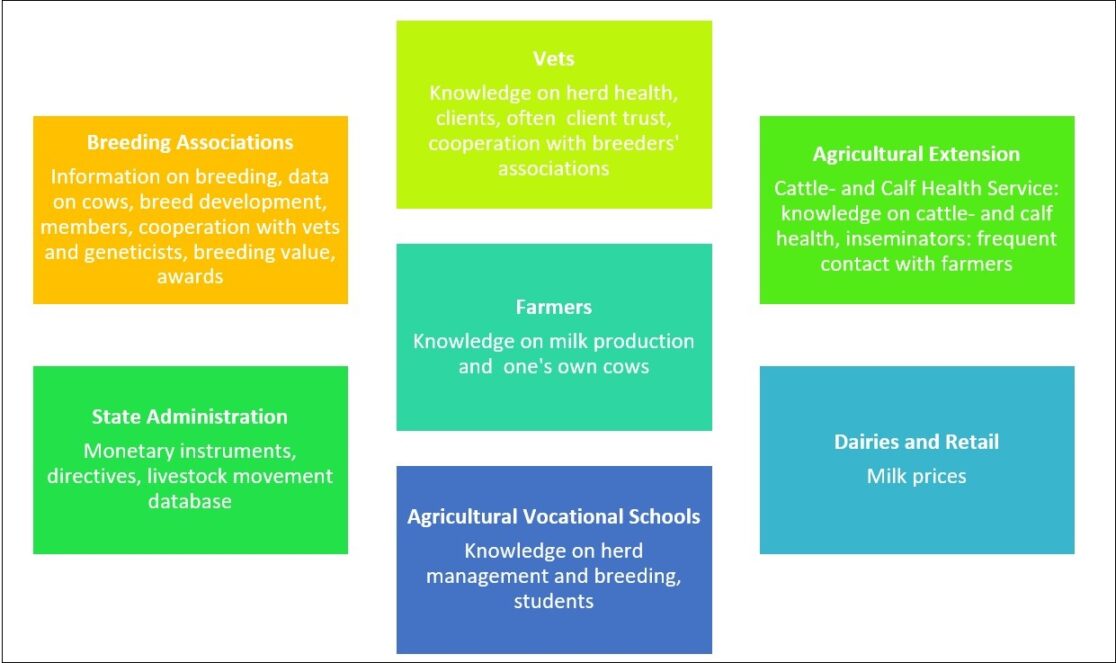Extending the Productive Life of Dairy Cows: Who Has a Say?
Photo: Johann Marmy,
Agroscope
Which stakeholders in the dairy sector have an influence on the productive life of dairy cows? Research results from FiBL and Agroscope suggest that broad-based cooperation is needed to create structures for a longer productive life.
The productive life of dairy cows is measured by the number of lactations, as well as by productive days in milk production. In general, it ends with the slaughter of the animals, or (substantially less often) with the switch to suckler-cow husbandry. Productive life is an indication of milk-production efficiency with respect to climate-change impact and economic efficiency, since during the cattle-rearing phase no revenue is earned although emissions are generated.
Farmers’ culling decisions are influenced by framing conditions
There are scientific papers that have shown that the economic and ecological optimum for dairy-cow productive life is higher than the productive life currently achieved in Switzerland and elsewhere. It is the farmers who ultimately make the decision of whether and when a cow is slaughtered. Even so, they do not act in a vacuum; their decisions are influenced by structural framing conditions which are in turn determined by various actors in the dairy industry.
Various stakeholder groups determine the framing conditions of the dairy industry
Qualitative interviews with 29 dairy industry stakeholders were used to analyse which stakeholder groups could potentially leverage which resources in order to extend the productive life of dairy cows. The interviewees comprised representatives of farmers’ and breeders’ associations, vets, retailers, agronomists, NGOs, representatives of the federal agencies and agricultural extension advisors. In addition to the scope of influence of these stakeholder groups, macroeconomic conditions and the farmers’ behaviour were mentioned.

Together, stakeholders have a major influence on productive life
Although all stakeholder groups have more or less strong opportunities to influence productive life length, they have the impression of not being able to exert any influence as individuals. A coalition of farmers jointly calling for better framing conditions for a longer productive life could change the situation. Framing conditions tending to militate against longer use of dairy cows are, for example, the Ordinance on the Use of Antibiotics and the regulations and price reductions with respect to milk cell counts. The same is true for high meat prices, additional costs for herd health advice from a vet and a focus on breeding progress on the part of farmers and breeders’ associations. Given that the monetary benefit for farms of a longer productive life can only be discerned after a complex cost analysis which farmers tend not to do, the option of farmers jointly calling for better framing conditions is unlikely. A rapid increase in the productive life of dairy cows is therefore only to be expected if all relevant stakeholders simultaneously intensify their efforts. Such cooperation, with the joint use and combination of the available resources, would make a longer productive life for Swiss dairy cows substantially more likely.
Conclusions
- Dairy cows tend to be slaughtered too early, before the economically and ecologically optimal time.
- When making decisions about the slaughter of cows, farmers are faced with framing conditions that tend to predispose them to earlier culling.
- The relevant individual stakeholders – farmers, breeders’ associations, vets, retail, education and extension, the government – feel unable to exert a meaningful influence when it comes to extending the productive life of dairy cows.
- Mutual cooperation among stakeholders and the pooling of their resources could lead more quickly to new framing conditions that would make it easier for farmers to extend the productive life of their dairy cows.
Bibliographical reference
Extending the Productive Life of Dairy Cows: Who Has a Say?



